SOCIAL MEDICINE & COMMUNITY HEALTH
PAPER – III
Note : This paper contains seventy five (75) objective type questions of two (2) marks each. All questions are compulsory.
1. Sputum positive TB cases on chemotherapy should be isolated at least for
(1) 2 weeks
(2) 3 weeks
(3) 4 weeks
(4) 6 weeks
2. In which of the following cancers, screening procedure maximally increases the overall survival
(1) Prostate cancer
(2) Lung cancer
(3) Colon cancer
(4) Ovarian cancer
3. Which vaccine is contraindicated in pregnancy ?
(1) Rubella
(2) Diphtheria
(3) Tetanus
(4) Hepatitis B
4. Kangaroo mother care is all essential for ensuring the best care options especially for Low Birth Weight (LBW) babies which includes all except
(1) Skin to skin positioning of a baby
(2) Adequate Nutrition through exclusive breast feeding (EBF)
(3) Ambulatory care as a result of early discharge
(4) Early detection of inadequate breast feeding and introduction of artificial feeding with Infant Milk Formula (IMF)
5. Phrenoderma occurs due to deficiency of essential fatty acid in diet and found in the following states except :
(1) W. Bengal
(2) Kerala
(3) Karnataka
(4) Gujarat
6. Sputum examination is method of choice for tuberculosis for all of the following except :
(1) Reliability
(2) Cheap
(3) Ease
(4) Non invasive nature
7. Twelve strategic themes to achieve in the socio-demographic goals for 2010 and suggested ways for implementation as follows except :
(1) Convergence of service delivery at village
(2) Convergence of service delivery subcentre level
(3) Child health and survival
(4) I.E.C.
8. Health policy research (in health policy and program) envisaged an increase in government funded health research to a level
(1) 1% of the total health spending by 2010
(2) 2% of the total health spending by 2010
(3) 3% of the total health spending by 2010
(4) 4% of the total health spending by 2010
9. The data collected through which of the following methods is not commonly used for surveillance
(1) Vital registration
(2) Disease notification
(3) Population surveys
(4) Passive reporting of cases
10. The social relationships derived from blood ties and marriage are collectively termed as
(1) Cognate
(2) Kinship
(3) Family
(4) Polyandry
11. In a study of vaccination in a community, if the category is classified as vaccinated or unvaccinated individuals, then the variable is
(1) Nominal scale
(2) Ordinal scale
(3) Interval scale
(4) Ratio scale
12. In IDSP a patient treated by a PHC medical officer is reported on
(1) D form
(2) L form
(3) P form
(4) S form
13. The urban population in Kerala (2011 senses) was
(1) 37.7%
(2) 42.7%
(3) 47.7%
(4) 52.7%
14. In a case control study we can calculate
(1) Incidence in exposed group
(2) Incidence in unexposed group
(3) Relative risk
(4) Odds ratio
15. The population of community A, on average, is older than community B. Assuming that the quality of health services and other parameters are similar, then
(1) The crude mortality rate in community A will be more than community B.
(2) The crude mortality rates in both communities A and B will be same.
(3) The age adjusted mortality in community A will be higher than community B.
(4) The age adjusted mortality rates in community B will be higher than in community A.
16. The WHO Essen schedule of the inactivated purified cell culture vaccine with a potency of at least 2.5 I.U per single intra muscular dose for post exposure prophylaxis for rabies is at days
(1) 0, 3, 7, 28, 90 (day 90 dose is optional)
(2) 0, 7, 14, 28, 90 (day 90 dose is optional)
(3) 0, 3, 7, 14, 28 with an optional dose on day 90
(4) 0, 3, 7, 14, 21, 28, with an optional dose on day 90
17. Median is the value that :
(1) is the average of the lowest and the highest value.
(2) occurs most often.
(3) has half the observation below it and half above it.
(4) is statistically closest to all of the values in the distribution.
18. According to WHO (2015), which two countries continue to remain polio-cadmic ?
(1) Pakistan and Afghanistan
(2) India and Bangladesh
(3) Sri Lanka and Pakistan
(4) Afghanistan and Nepal
19. Which of the following terms connate action of social groups to maximize their own advantage by restriction to access to rewards to their members and thus closing access to outsides ?
(1) Social distance
(2) Social control
(3) Social contract
(4) Social closure
20. The denominator in GFR (General Fertility Rate) is
(1) Women aged 15-44 years
(2) Total female population
(3) Total population
(4) All births in the same year
21. According to various community based surveys, prevalence of common mental disorders in India (Annual report, G.O.I, 2013-14)
(1) 16-17%
(2) 11-12%
(3) 6-7%
(4) 1-2%
22. The area under a normal curve within 2 standard deviations is
(1) 65%
(2) 75%
(3) 95%
(4) 99%
23. The process of contacts between different cultures and also the outcome of such contacts is called
(1) Ascription
(2) Adaptation
(3) Assimilation
(4) Acculturation
24. High essential fatty acid source for linoleic acid has been found in
(1) Corn oil
(2) Sunflower oil
(3) Safflower oil
(4) Soyabean oil
25. Providing continuum to health policy 1983, the strategy of primary health care has been adopted as the key strategy in the new health policy with emphasis on
(1) Equitable access to health services
(2) Public private partnership
(3) Specialisation in public health and family medicine
(4) Involvement of NGO
26. In 1911, the concept social medicine was revived by a persons who stressed the importance of social factors in the actiology of diseases.
(1) Robert Koch
(2) Edwin Chadwick
(3) Wislow C.E.A.
(4) Alfred Grotjahan
27. Japanese encephalitic is transmitted by the vector mentioned below :
(1) Culex fatigens
(2) Culex Tritaeniorhynchus
(3) Aedes Mosquito
(4) Louse
28. An infant aged 90 days had diarrhea casting for 14 days or more classified as severe persistent diarrhoea and will be given treatment as per IMNCI guidelines as follows except
(1) Give first dose intramuscular ampicillinor gentamycin if the young infant has low weight, dehydration or another severe classification.
(2) Treat to prevent low blood sugar
(3) Refer to hospital
(4) Give fluid and food to treat diarrhoea at home
29. Mass drug administration in National Filaria Control Program is given in a single day & the dose of DEC was
(1) 6 mg/kg of body weight annually
(2) 10 mg/kg of body weight annually
(3) 16 mg/kg of body weight annually except children under 2 years, pregnant women and seriously ill patients.
(4) 6 mg/kg of body weight except children under 2 years, pregnant women and seriously ill patient.
30. 5 cleans include all except one as follows :
(1) Clean surface for delivery
(2) Clean hands of the attendant
(3) Clean cord tie
(4) Clean cord stamp with applicant
31. In national immunization programme transport of vaccine in cold chain means
(1) Transport from manufacturer to PHC
(2) Transport from PHC to subcenter
(3) Transport from subcenter to vaccine site
(4) Transport from manufacturer to vaccine site
32. Normal range of body mass index is
(1) below 15.00
(2) 15 to 18.50(3)
18.5 to 24.99
(4) 24.99 to 35
33. Weight of the new born trebles by the age of
(1) 6 months
(2) 8 months
(3) 10 months
(4) 12 months
34. Sickness benefit in ESIS is
(1) Out patient care
(2) Domiciliary services
(3) In patient treatment
(4) Cash payment to insured person
35. What is the colour coding of bags in hospitals to dispose off human anatomical wastes such as appendix ?
(1) Red
(2) Blue
(3) Yellow
(4) Black
36. Which of the following diseases are transmitted as Anthro-zoonoses ?
I. Rabies
II. Plague
III. Guinea worm infestation
IV. Hydatid cyst
Codes :
(1) I, II and IV are correct
(2) I, III and IV are correct
(3) I, II and III are correct
(4) II, III and IV are correct
37. Which of the following types of vaccines can be given to an immunocompromised child ?
I. Recombinant
II. Subunit
III. Killed
IV. Live attenuated
Codes :
(1) I, II and IV are correct
(2) I, II and III are correct
(3) I, III and IV are correct
(4) II, III and IV are correct
38. Which of the following are the example of nominal scale ?
I. Race
II. Sex
III. Blood pressure
IV. Body weight
Codes :
(1) I, III and IV are correct.
(2) III and IV are correct.
(3) I and II are correct.
(4) I, II and III are correct.
39. Which of the following constitute symbolic interactionism ?
I. Diffusionism
II. Behaviourism
III. Significant symbols
IV. Pragmatism
Codes :
(1) I, III and IV are correct.
(2) I, II and IV are correct.
(3) I, II and III are correct.
(4) II, III and IV are correct.
40. Which of the following statements are true about ‘Likert Scale’ ?
I. It is a ‘Cummulative scale’
II. It is also known as ‘Summative Scale’.
III. It is a type of ordinal scale.
IV. It is generally used to quantity attitudes and behaviour.
Codes :
(1) I and II are correct.
(2) I, II and III are correct.
(3) II, III and IV are correct.
(4) I and IV are correct.
41. Which of the following statements are true about dengue ?
I. Haēmorrhagic tendency
II. Spontaneous remission
III. Transmitted by Anopheles mosquito
IV. Fever is saddle back type
Codes :
(1) I, II and III are correct.
(2) I, II and IV are correct.
(3) II and III are correct.
(4) II, III and IV are correct.
42. The screening tests are
I. Based on one criterion or cut off point.
II. Very accurate
III. Less expensive
IV. Forms the basis of treatment
(1) I, II
(2) I, III
(3) I, IV
(4) II, III
43. Human development index includes :
I. Life expectancy at birth
II. Adult literacy rate
III. Income
IV. Infant mortality rate
The correct answer is
(1) I, II and III are correct
(2) I and III are correct
(3) III and IV are correct
(4) I and II are correct
44. Which of the following statements about plague are correct ?
I. Domestic rat is main reservoir.
II. Bubonic is the most common variety.
III. The causative bacillus can survive upto 10 years in the soil of rodent burrows.
IV. Incubation period of pneumonic plague is one to two weeks.
Codes :
(1) I and II are correct.
(2) I, II and III are correct.
(3) I, III and IV are correct.
(4) II, III and IV are correct.
45. Which of the following are measures of dispersion around central value ?
I. Mode
II. Variance
III. Standard Deviation
IV. Standard Error of mean
Codes :
(1) I and IV
(2) II, III and IV
(3) I, II and III
(4) I, II and IV
46. Match the following :


47. According to Bio-Medical Waste (Management and Handling) rule 1998, colour coding of containers and categorization of Biomedical waste is done. Identify the correct matching of colours of containers and types of biomedical waste :
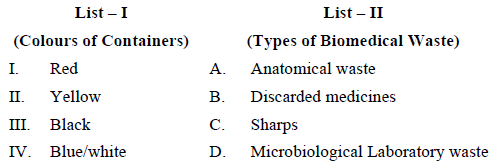

48. Different missions and schemes has been launched to achieve improvement in specific area of health care. Identify correct matching of missions/schemes and the underlying purpose :
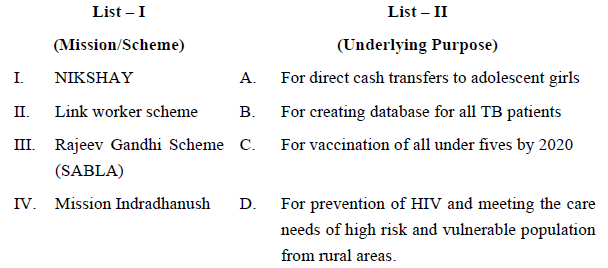
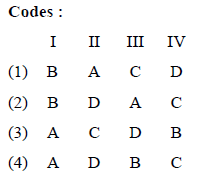
49. Match the level of Heath Care and institution providing health care in that level


50. Transmission of HIV infection in India NACO (2010-11)


51. Match the drugs and doses under RNTCP :


52. Match the following classification of dehydration and signs based on IMNCI norms :

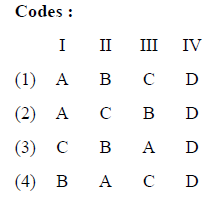
53. Which one of the following are correctly matched ?
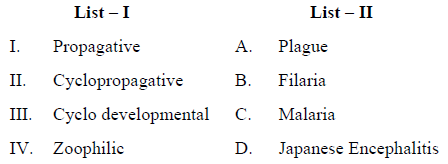

54. Match the following :
Common environmental radiations and their penetrating power in tissues :


55. Match the major causes of maternal deaths in India with estimated proportion (SRS Survey 2001-2003)


56. Identify correct descending order of causes of blindness in India as per national survey on blindness 2006 – 2007 :
(1) Corneal opacity, Glaucoma, Cataract, Refractive error
(2) Cataract, Refractive error, Glaucoma, Corneal opacity
(3) Glaucoma, Corneal opacity, Cataract, Refractive error
(4) Cataract, Glaucoma, Refractive error, Corneal opacity
57. Arrange the acceptable noise levels in descending order in dB
(1) Restaurants, Conference, Hospital ward, Classroom
(2) Restaurants, Conference, Classroom, Hospital ward
(3) Classroom, Restaurants, Conference, Hospital ward
(4) Restaurants, Classroom, Conference, Hospital ward
58. Correct sequence of countries according to increasing maternal mortality is
(1) U.S.A., Japan, India, Nepal
(2) U.S.A., Japan, Nepal, India
(3) Japan, U.S.A., India, Nepal
(4) Japan, U.S.A., Nepal, India
59. Arrange the following common cancers in female as per descending order of % of total mortality (2012) worldwide :
(1) Colorectum, Liver, Ovary, Breast
(2) Breast, Liver, Colorectum, Ovary
(3) Liver, Breast, Ovary, Colorectum
(4) Breast, Colorectum, Liver, Ovary
60. Correct chronological order of changing phases in public health is
(1) Disease control, social engineering, health promotion, health for all
(2) Disease control, health promotion, social engineering, health for all
(3) Disease control, health for all, health promotion, social engineering
(4) Social engineering, health promotion, disease control, health for all
61. Identify correct descending order of causes of death as per WHO fact sheet No 310, (2013) of low income countries
(1) Malaria, Stroke, Lower respiratory infections, Diarrhoeal diseases
(2) Lower respiratory infections, Diarrhoeal diseases, Stroke, Malaria
(3) Diarrhoeal disease, Malaria, Stroke, Lower respiratory infections
(4) Lower respiratory infections, Diarrhoeal diseases, Malaria, Stroke
62. Select the correct chronological sequence for selected policies in India :
(1) First National health policy, National policy for older people, National population policy, National policy for children
(2) First National health policy, National population policy, National policy for children, National policy for older people
(3) National population policy, First National health Policy, National policy for older people, National policy for children.
(4) National policy for children, First National health policy, National policy for older persons, National population policy.
63. Identify the correct chronological sequence of selected themes of the world health day :
I. Food safety
II. Road safety
III. Global Polio Eradication
IV. Protecting Health from adverse effect of climate change
Codes :
(1) I, III, IV, II
(2) III, II, I, IV
(3) III, II, IV, I
(4) III, I, II, IV
64. Chronological order for occurrence of disability is
(1) Disease, impairment, disability, handicap
(2) Disease, disability, impairment, handicap
(3) Disease, impairment, handicap, disability
(4) Disease, handicap, impairment, disability
65. Select the correct sequence for laboratory investigation (if available) of lower abdominal pain in females as per the guidelines of NACO for the control of RTI/STIs.
(1) Wet smear examination, gram stain for gonorrhoea, complete blood count & ESR, urine microscopy for pus cell.
(2) Complete blood count and ESR, gram stain for gonorrhoea, wet smear examination, urine microscopy for pus cell.
(3) Urine microscopy for pus cell, gram stain for gonorrhoea, complete blood count and ESR, wet smear examination.
(4) Gram stain for gonorrhoea, wet smear examination, complete blood count and ESR, urine microscopy for pus cell
Instructions : (For Q. No. : 66 to 75)
Assertion and Reasoning : In the context of two statement, which one of the following is correct :
1. Both A and R are true and R is the correct explanation.
2. Both A and R are true, but R is not the correct explanation.
3. A is true but R is false.
4. A is false but R is true.
66. Assertion (A) : In balanced diet recommended by ICMR, most of dietary proteins are provided by cereals.
Reason (R) : Cereals have a lower proportion of proteins than pulses.
67. Assertion (A) : Kerala has surpassed all the Indian states in certain important measures of health and social development.
Reason (R) : The population density of Kerala is very low.
68. Assertion (A) : Usually members of a family share a pool of genes.
Reason (R) : Family is a group of biologically related individuals living together.
69. Assertion (A) : In India water pollution is becoming a serious public health problem.
Reason (R) : Drinking water seldom contains zinc concentrations above 0.1 mg/litre.
70. Assertion (A) : Post exposure immunisation may be useful for control of measles.
Reason (R) : Incubation period for vaccine strain in measles vaccine is similar to wild strain.
71. Assertion (A) : Some diseases like Hypertension, Malnutrition show iceberg phenomenon.
Reason (R) : Floating tip of the iceberg represent what physician sees and submerged portion represent the hidden mass of disease.
72. Assertion (A) : Cholera is often called the ‘father of public health’.
Reason (R) : John Snow studied the epidemiology of cholera in London from 1848 to 1954 and established the role of polluted drinking water in the spread of cholera.
73. Assertion (A) : Fogging is an effective larvicidal measure.
Reason (R) : Control of mosquito breeding is essential for effective control of mosquito borne diseases.
74. Assertion (A) : Access to Essential medicines in all public health facilities is a priority.
Reason (R) : To cut down the costs and rational use of drugs, generic drugs are recommended.
75. Assertion (A) : Unlinked anonymous blood screening is performed for preventing transfusion related HIV infection.
Reason (R) : Most of new HIV infections in country are transmitted through infected blood and blood related products.
Latest Govt Job & Exam Updates: